Wine Lister’s COO, Chloe Ashton shares her thoughts on this year’s en primeur campaign so far.
The latest Bordeaux en primeur campaign is already underway, with Batailley 2021 opening the stage at the beginning of last week, and Domaines Baron de Rothschild’s Carruades and Duhart-Milon following suit. Cantemerle’s release on Friday 13th rounded out the week, and thus far starting prices have been a relatively pleasant surprise.
What does the trade expect from this year’s campaign?
In Part I of Wine Lister’s annual Bordeaux study, we asked key members of the global fine wine trade about their expectations ahead of the 2021 campaign. Of 47 respondents, half expected prices to be somewhat more expensive, or significantly more expensive than 2020 vintage releases, after rumblings on La Place of strong trading over the past few months.
 Bordeaux study (p.10): Founding members survey – 2021 release price expectations
Bordeaux study (p.10): Founding members survey – 2021 release price expectations
After the first physical en primeur week in Bordeaux since the 2018 vintage (our view of the vintage can be found here), the trade will at least have had the chance to work their way through a vintage so complex that tasting was surely a necessity. With such a heterogenous vintage, pricing strategies should logically also be extremely varied, making the potential successes of 2021 sales difficult to predict. Nonetheless, here’s what we know:
- Wine Lister’s annual Bordeaux study reveals that confidence in Bordeaux us up. Respondents increased ratings on last year for three quarters of the wines included in our study – after so many trade members have been reminded of the joys of tasting in situ, both these elements could contribute to campaign positivity and momentum, with merchants backing those properties they historically believe in, and/or were indeed impressed by during en primeur tastings
- 2021 appears to be a vintage that speaks from the soil, so imparting knowledge of the best terroirs to customers should help to create demand for the best-performing wines in general
- Outside of focusing only on the very best, 2021 may be a vintage for pleasant surprises – the fresher, lower-alcohol, and more classical style of wines certainly garner appeal from traditional palates, so any merchant or collector seeking this style of drinking experience in the near to mid future could do well in seeking out some of the better-value wines hailing from this complicated campaign
Wine Lister’s wine-by-wine analysis of this year’s campaign is available in email newsletter form through a Pro+ subscription. For more information on this, please contact us.
Wine Lister’s Founder and CEO, Ella Lister shares her thoughts on Bordeaux’s 2021 vintage.
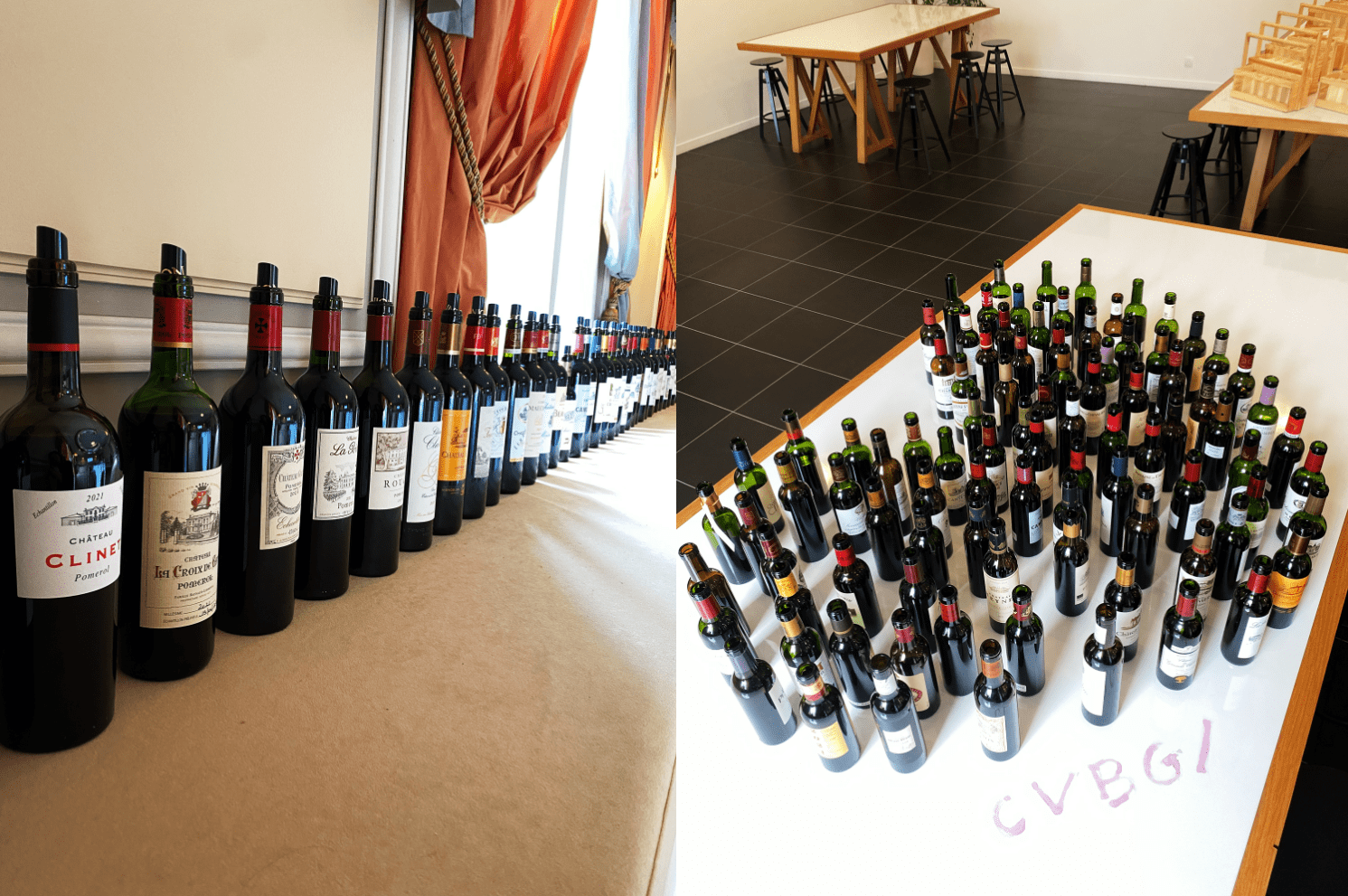 Bordeaux en primeur tastings: UGCB (left) and CVBG (right)
Bordeaux en primeur tastings: UGCB (left) and CVBG (right)
What can we expect from Bordeaux 2021?
The most complicated vintage since 2013, Bordeaux 2021 had everything thrown at it. The vines suffered a barrage of challenges during the growing season, from frost, then mildew, to a lack of the all-important hydric stress during a cool, cloudy summer. “It was a tiring vintage for us, and psychologically difficult” recalls Juliette Couderc, the new technical director at Château L’Evangile.
Bordeaux had been lucky with six relatively clement vintages in row, and en primeur tasters had been spoiled – especially with the trio of 2018, 2019, and 2020. Tasting more than 350 wines from the 2021 vintage in late April, we were reminded of en primeur tastings of old – the art of seeing through the wood, the hard tannins, the searing acidity, and attempting to form an idea of the wine’s future potential. And potential there is, if much less widespread than in the last three years. Buying decisions will need to be made carefully, and the critics’ views will be more important than in recent vintages blessed with high quality across the board.
Vinegrowing and winemaking have come on even in nine years, with know-how and tools at the disposal of producers that they didn’t necessarily have in 2013. Furthermore, 2021 had a saving grace – an unusually long growing season, beginning with early bud break, around the beginning of April, and ending with harvest dates running well into October, thanks to an Indian summer that finally provided some much-needed sunshine, with the sunniest October since 1991. Pierre-Olivier Clouet, technical director of Château Cheval Blanc, referred to a vintage “slow-cooked at a low temperature” following six years of cooking “on a high heat”.
The vintage was more challenging for merlot than for cabernet (franc or sauvignon), as the grape variety is more susceptible to mildew. Being an early ripener, merlot also missed out on the best of the Indian summer, whereas much cabernet benefitted from a warm and sunny early October, where vignerons dared to ignore the pessimistic weather forecasts for the weekend of 3rd and 4th October and hadn’t already rushed to pick before the non-existent rain. “The weather forecast was predicting an apocalypse,” recalls Vincent Millet, managing director of Château Calon-Ségur in Saint-Estèphe, but the cabernet grapes weren’t ready, so he waited, “and in the end there was no rain at all, and then a good stint of sunshine”. Further south in Margaux, Alexis Leven-Mentzelopoulos, co-owner of Château Margaux, echoes, “It was out of the question to pick unripe grapes ”.
At Château Ducru-Beaucaillou in Saint-Julien, owner Bruno Borie says the 2021 vintage is an “ode to cabernet sauvignon, which was much more resistant than merlot at every step.” However, cabernet’s upper hand in 2021 does not neatly translate into a left-bank vintage as might be expected. The right bank has its fair share of hits, and, bizarrely, fewer misses.
The watchword in 2021 is heterogeneous, and quality is undoubtedly very patchy in 2021, ranging from the seriously disappointing to the truly exceptional (though we are not in 100-point territory in this vintage). This makes it a hugely interesting en primeur campaign to taste, to sell, and to buy. It is a year where châteaux had a real opportunity to stand out from the pack, usually thanks to outstanding terroir and the application of significant resources – both financial and human. “It was viticulture seven days a week,” explains Jean-Emmanuel Danjoy, estates manager of the Château Mouton-Rothschild stable, who, like many others, underlined the vital importance of the team’s unstinting dedication. It was necessary to adapt tirelessly in the vineyard and in the winery; to accept that the fruit coming in at the end of the season wasn’t that of the three previous vintages, and be willing to throw out tried and tested recipes to make a different kind of wine, suited to the vintage. “We didn’t go looking for density that simply wasn’t there”, underlines Vincent Decup, technical director at Château Montrose in Saint-Estèphe. Down the road at Cos d’Estournel, Dominique Arangoïts points out “it’s an opportunity for wine lovers to really uncover the terroir, because the wines are stripped right back.”
The biggest challenges were to achieve a full enough body and to avoid vegetal (pyrazine) notes, without over-extracting hard, green tannins or being over-reliant on new wood, which the more delicate fruit couldn’t absorb. Many of the more successful properties used gentler extraction techniques than ever, and added a significant proportion of press wine to fill out the mid-palate. Chaptalisation was widely resorted to for the first time since 2013. The 2021 vintage nonetheless offers refreshingly modest alcohol levels – around 13% rather than the 15% or 15.5% which had become ubiquitous in recent years – potentially a key selling point with consumers.
Generalisations are not easy (or wise) in a vintage of such disparity of quality and style, but with few exceptions, the red wines tend to come in a lighter, fresher vein, recalling the classical clarets of the 1980s and 1990s. “It’s a wine style from the 80s, but with ripe grapes,” muses Aymeric de Gironde, president of Château Troplong-Mondot. The fruit is more red than black, with lots of raspberry and even some rhubarb. The vintage is less opulently floral than the last three, and floral notes are more often on a slightly more vegetal spectrum – iris, violet and lily. The worst wines have hollow mid-palates and searing acidity, and often an overdose of oak. The very best are so pure and soothing that you would never imagine the sweat and tears that went into making them. For Olivier Gautrat, maître de chai at Château L’Eglise Clinet, it was “a difficult and exhausting vintage. We’ve been out of the habit of less explosive flavour in the grapes, so we were really scared, but the more we taste, the more we find real charm in the 2021s. ”
The dry whites are pure and fresh, and the best have a sumptuous complexity. The sweet whites are remarkable, but produced in tiny quantities, if at all. For this reason Christian Seely describes Château Suduiraut 2021 as “tragically beautiful”, with yields of less than 1 hl/ha. What the reds, whites, and sweet wines all share is high acidity, which will likely result in long ageing capacity. We look forward to tasting the wines again in bottle in a couple of years to confirm that!
350+ tasting notes will be published (in French) at Le Figaro Vin next week. In the meantime, watch this space for part II of this blog series, with a focus on the Bordeaux market, to be published next week. To track the impending Bordeaux en primeur releases, click here to discover our en primeur page.
A tour of the town with our Pessac-Léognan friends
The Larrivet Haut-Brion team joined Wine Lister to catch up with industry friends and meet some new faces in London’s fine wine scene after two years of restricted travel. Alongside a wine and cheese consumer tasting and a trade lunch, a series of individual merchant meetings provided the chance for the team to reunite with a market close to their hearts.
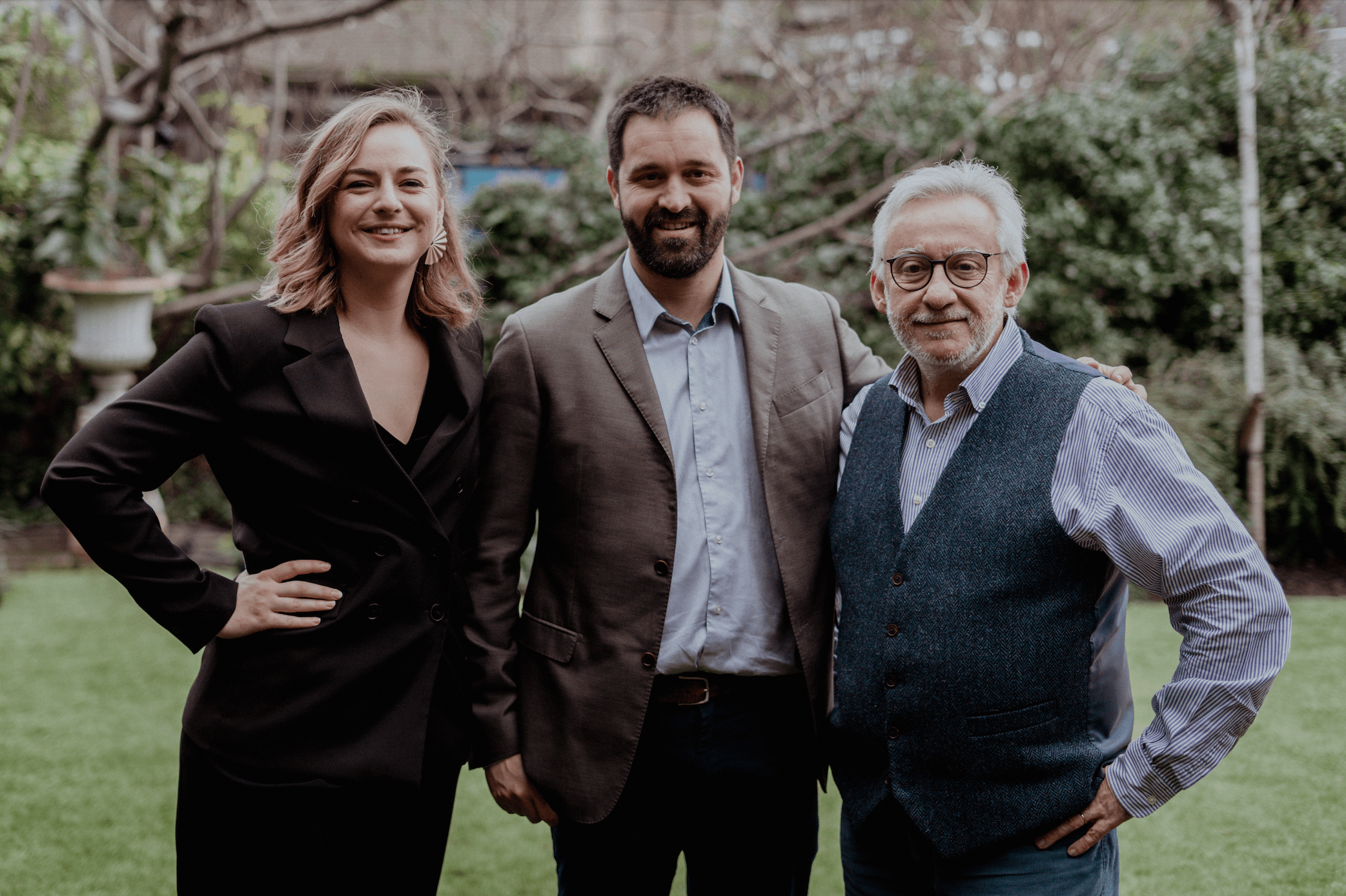 Larrivet Haut-Brion in London: (from left) Brand Ambassador Clara Bouineau, Technical Director François Godichon, Managing Director Bruno Lemoine
Larrivet Haut-Brion in London: (from left) Brand Ambassador Clara Bouineau, Technical Director François Godichon, Managing Director Bruno Lemoine
What are the latest developments at Larrivet Haut-Brion?
The viticultural evolution at Larrivet Haut-Brion kick-started with the arrival of their Managing Director, Bruno Lemoine in 2007. Fascinated by the mosaic soil structure unique to the property (with top-soils composed in patterns of graves, colluviums, or sand and clay-limestone), Bruno conducted extensive terroir analysis which informed a detailed replanting programme, allowing the team to better match grape varieties to soil types for optimum quality. Among other changes, this led to an increased proportion of Cabernet Sauvignon and Cabernet Franc vines planted across the vineyard sites.
Further changes were implemented in 2015 with the arrival of Technical Director, François Godichon, who integrated several new production methods informed by his Burgundian roots. His parcel-led approach was reinforced in 2018 with the construction of a new cellar with space and facilities for a more precise vinification of individual micro-plots.
The final piece in Larrivet Haut-Brion’s winemaking puzzle, Cellar Master, Charlotte Mignon joined the team in 2020 and drives continuous experimentations with different ageing vessels, including combinations of concrete eggs, terracotta amphorae, and both new and old oak barrels. With Charlotte unavailable to join the visit (having just welcomed her second child), the London trio was completed by the property’s Brand Ambassador, Clara Bouineau, who joined the team in January 2022.
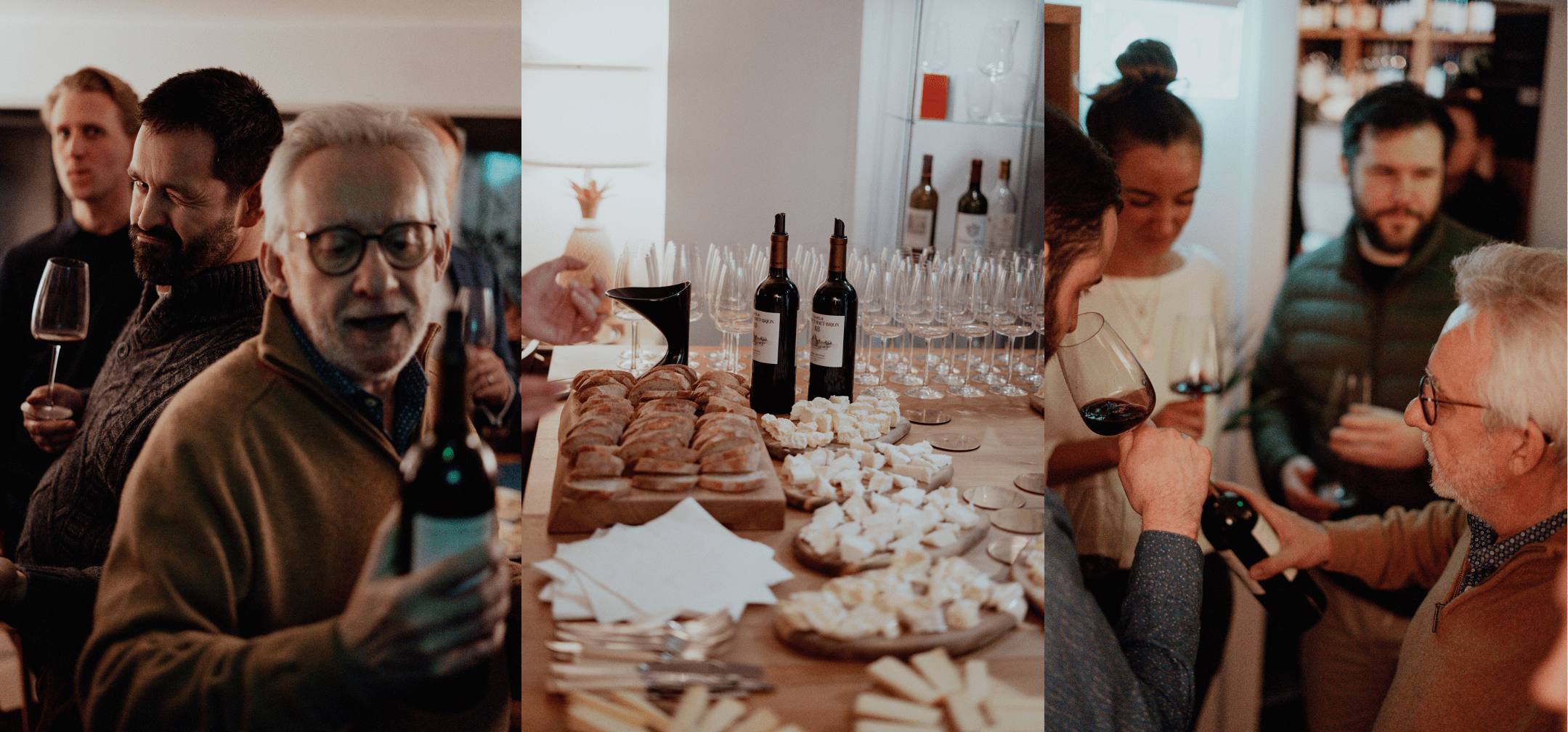 Wine and cheese tasting: Bruno and François tell guests about their wine (left), wine and cheese at Must & Lees (middle), Bruno pouring wine for guests (right)
Wine and cheese tasting: Bruno and François tell guests about their wine (left), wine and cheese at Must & Lees (middle), Bruno pouring wine for guests (right)
A marriage of Bordeaux wine with British cheese
The first stop on Larrivet Haut-Brion’s London tour was specialist wine shop Must & Lees, where the team was joined by some of North London’s Bordeaux enthusiasts for a wine and cheese evening on Wednesday 23rd February. Celebrating the estate’s commitment to the UK market, Wine Lister and Larrivet Haut-Brion devised a tasting format that showcased their red and white wines alongside a selection of 100% British cheeses from Neal’s Yard Dairy. While providing the opportunity for the team to build relationships with its consumers, the evening showcased the suitability of Larrivet Haut-Brion wines with some of the UK’s favourite fromages, including the likes of St Jude and Colston Bassett Stilton.
Wine and cheese pairing: Larrivet Haut-Brion Blanc 2017 with Sinodun Hill, Les Demoiselles Blanc 2019 with St Jude, Larrivet Haut-Brion Blanc 2014 with Baron Bigod, Larrivet Haut-Brion Blanc 2007 with Durrus, Les Demoiselles Rouge 2019 with Ogleshield, Larrivet Haut-Brion Rouge 2017 with Colston Bassett Stilton
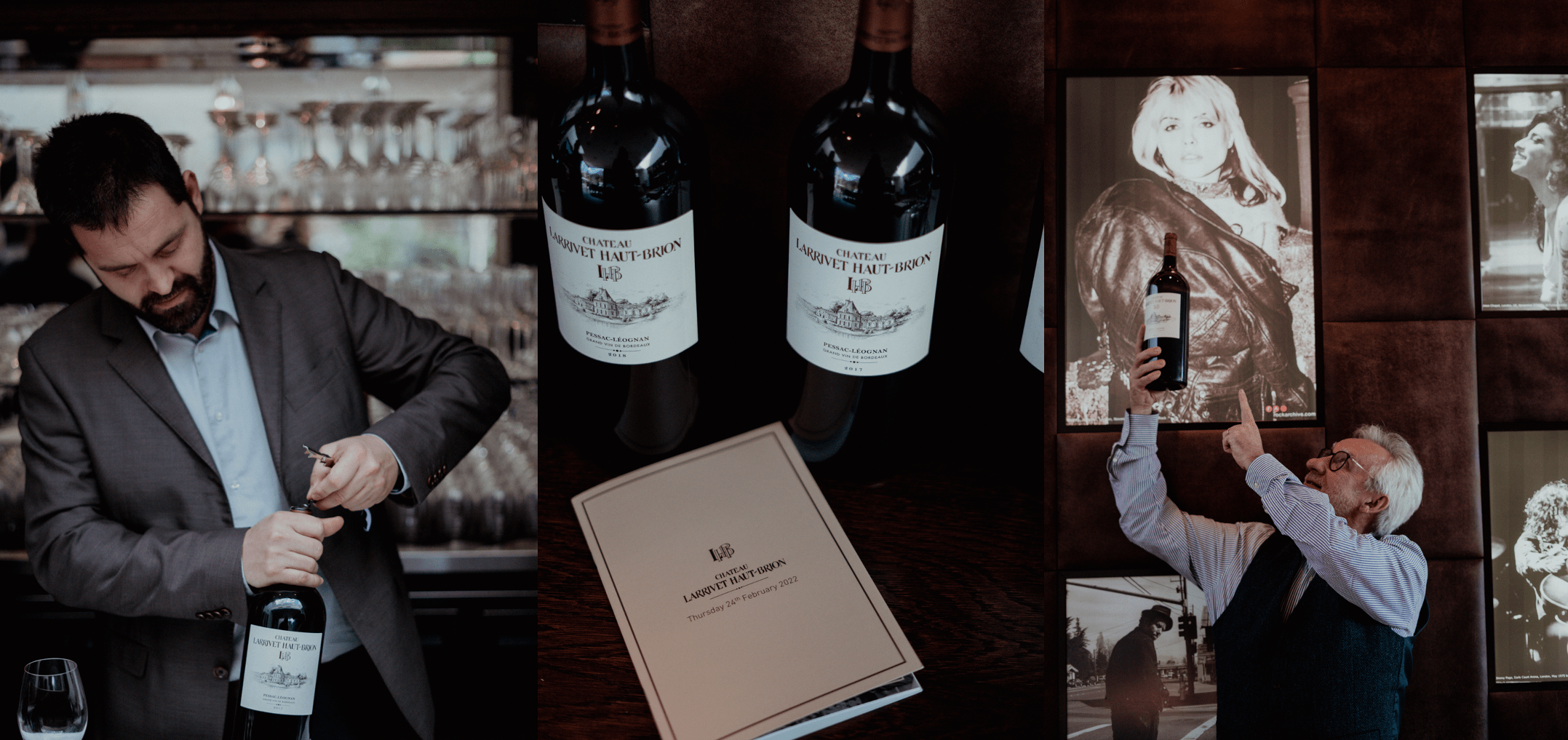 Frederick’s trade lunch: François opening a 2015 magnum (left), magnums on display with bespoke booklet (middle), Bruno presenting a magnum (right)
Frederick’s trade lunch: François opening a 2015 magnum (left), magnums on display with bespoke booklet (middle), Bruno presenting a magnum (right)
A taste for technical developments
Having already met with some of London’s key fine wine merchants, on Thursday 24th February, Wine Lister invited a handful of its fine wine trade and press friends for lunch at Frederick’s to discover some of Larrivet Haut-Brion’s best recent vintages in magnum.
With positive feedback across the board, Larrivet Haut-Brion’s whites showed freshness and complexity, thanks to the blending of Sauvignon Blanc with Sémillon from old vines grown on limestone soils. Alongside an impressive showing of some iconic recent vintages of reds (including 2005, 2010, 2015), the 2017 Rouge provided a promising picture of the future of Larrivet Haut-Brion 2021, with a low proportion of Merlot offset by a higher percentage of Cabernet Franc mirroring the projected blend of this year’s release – which may contain no Merlot at all.
To round off the lunch, the Larrivet Haut-Brion team poured some of their favourite wines from outside the property – an exercise that they believe is crucial to learn and gain inspiration from others. Amongst their “beyond Bordeaux” selection were Pierre Gerbais’ Prestige Extra Brut, Mas Jullien 2018, and Domaine Moingeon Saint-Aubin 1er Cru Sur Gamay 2018 – each giving guests a glimpse into the team’s personal preferences.
Wines tasted: Les Demoiselles Rouge 2019, Larrivet Haut-Brion Rouge 2019, Larrivet Haut-Brion Rouge 2018, Larrivet Haut-Brion Rouge 2017, Larrivet Haut-Brion Rouge 2016, Larrivet Haut-Brion Rouge 2015, Larrivet Haut-Brion Rouge 2010, Larrivet Haut-Brion Rouge 2005, Les Demoiselles Blanc 2020, Larrivet Haut-Brion Blanc 2020, Larrivet Haut-Brion Blanc 2019, Larrivet Haut-Brion Blanc 2018, Larrivet Haut-Brion Blanc 2011
For further information on WLPR’s tastings and events, please contact the team here.
Rounding off this year’s en primeur campaign, Wine Lister’s partner critic platform, JancisRobinson.com has now published its top Burgundy 2020 scores, with further insight into the latest vintage from Jancis Robinson, alongside Matthew Hayes, and fellow Masters of Wine, Andy Howard and Julia Harding.
Explore all Burgundy 2020 scores here, or read more below.
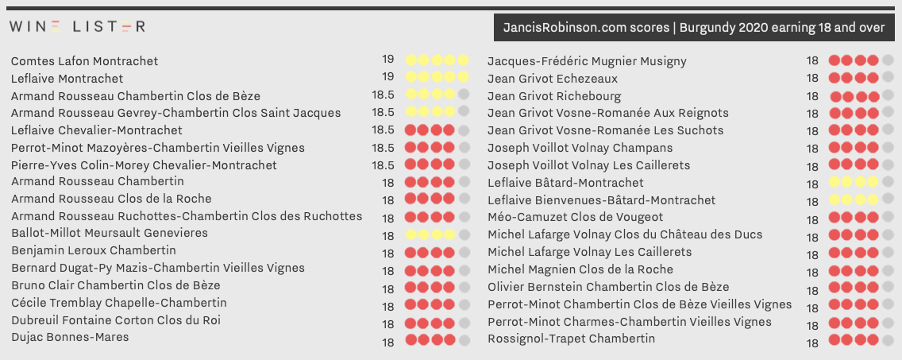
Amongst the 36 Burgundy 2020s that earn 18 and over, five wines receive 18.5 points and two receive a score of 19 – a slight reduction from the number of top scorers in last year’s campaign, with Jancis awarding 18.5 points to 18 Burgundy 2019s and a score of 19 to four wines.
Whites continue to steal the show across this year’s releases, with four receiving a score of 18.5 and above – compared to just one featured within the same parameters last year. Sharing a near-perfect score of 19 are Montrachets from Comtes Lafon and Leflaive – Matthew Haynes describes the former as “honed, dense, and focused”, and the latter as having a “beautiful balance and drive.”
Two producers dominate JancisRobinson.com’s top Côte de Nuits red scores; Armand Rousseau is featured five times in the list, for its Chambertin Clos de Bèze, Gevrey-Chambertin Clos Saint Jacques, Chambertin, Clos de la Roche, and Ruchottes-Chambertin Clos des Ruchottes, and Jean Grivot earns four places, with Richebourg, Echezeaux, Vosne-Romanée Les Suchots, and Vosne-Romanée Aux Reginots all achieving 18 points.
Despite the hot and dry summer causing difficulty to some of the Côte de Beaune reds, four wines from Volnay shine through; Michel Lafarge’s Volnay Les Caillerets and Clos du Château des Ducs, and Joseph Voillot’s Volnay Champans and Les Caillerets.
Discover more Burgundy 2020 scores from Wine Lister’s partner critic, Neal Martin here, an regional specialist, Jasper Morris here.
Insight from Burgundy’s regional specialist
Wine Lister’s partner critic and leading Burgundy expert, Jasper Morris MW completed the release of his Burgundy 2020 scores last week. Below we take a closer look at his top ratings per appellation subset.
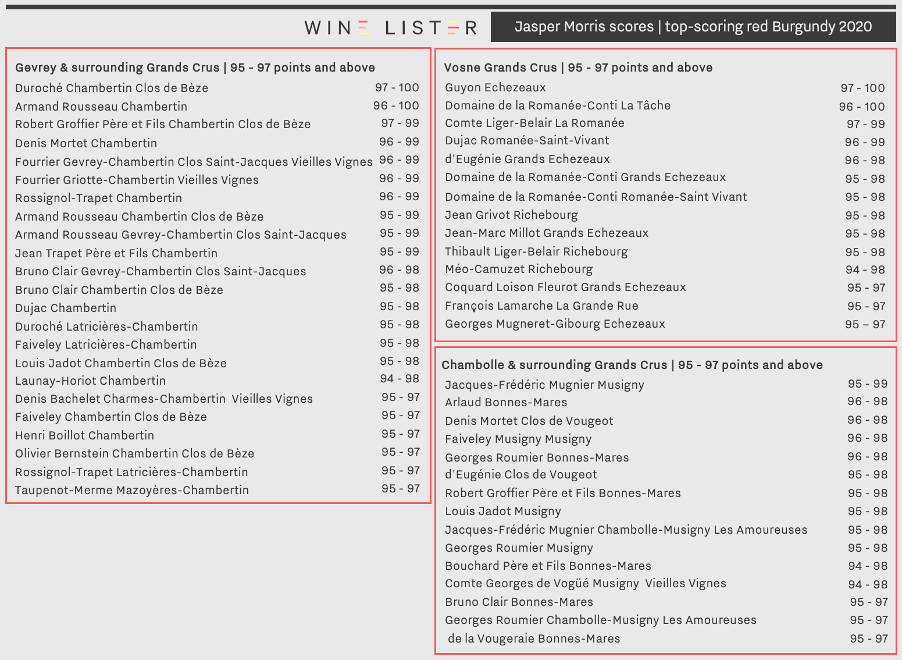
How did Burgundy’s appellations perform in 2020?
Jasper Morris’ Burgundy 2020 report outlines the challenges brought about by such a hot and dry summer, with soaring temperatures throughout August leading to a deficit of juice, particularly in Pinot Noir. The inability of certain rootstock to deal with the hot dry conditions led to the threat of dieback disease (a fungal disease that attacks the trunk, appearing more frequently in stressed vines), with Jasper noting he has “never seen as many vines being ripped out as [he] did in autumn 2020”. Indeed, both factors resulted in relatively low yields for reds, with a number of producers in the Côte de Nuits having “made more wine in the frost-damaged 2021 vintage than they did in 2020.”
Nonetheless, Jasper reported that the hydric stress “concentrated everything, including acidity”, identifying wines with “profound intensity beyond anything [he] saw in 2018 and 2019.” He describes a “universally successful vintage for the white wines”, and a “wider range of styles and successes in the reds”.
Côte de Nuits
With almost all of his top scores given as ranges, much of Jasper’s tasting this year took place whilst wines were still in barrel, as many producers were “tempted to increase the length of élevage for their wines, especially the reds, given the exceptional concentration of the fruit”. This contrasts with the majority of singular scores awarded to the in-bottle samples he rated at the same time last year, and while 2019 did not see any potential 100-point wines, the Côte de Nuits 2020s have five.
The selection includes Duroché’s Chambertin Clos de Bèze and Armand Rousseau’s Chambertin, with the former released as a limited edition cuvée to mark 100 years since the Duroché family planted vines on the site. Also potentially perfect are Guyon’s Echezeaux and Domaine de la Romanée-Conti’s La Tâche, with Jasper suggesting the former “could be THE wine of the vintage.” Completing the line-up is Perrot-Minot’s Richemone Vieilles Vignes, a Premier Cru with a vibrancy that Jasper considers “almost unsurpassed anywhere in the Côte”.
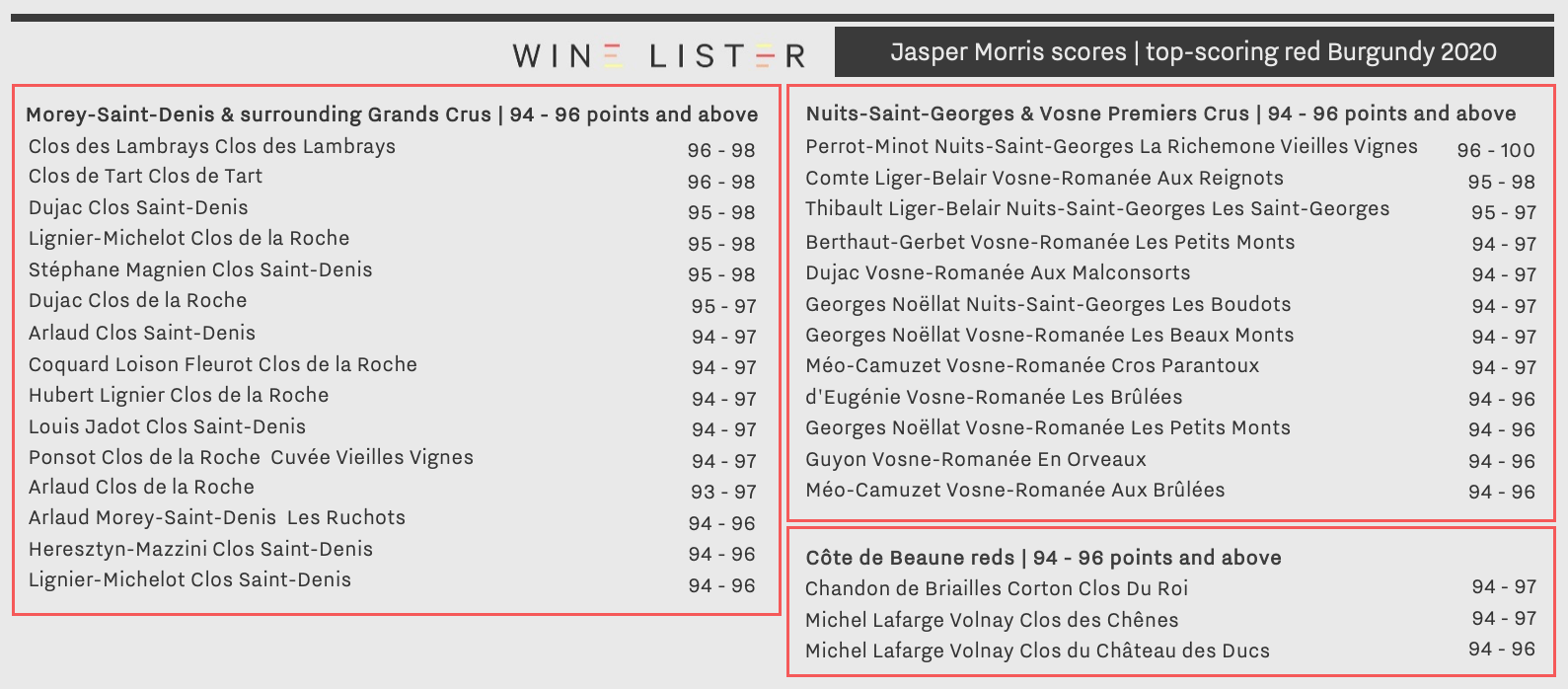
Within Morey-Saint-Denis and its surrounding Grands Crus, Clos de Tart’s namesake cuvée shares the top score for a second year in a row, earning 96 – 98 points, having been complimented for its “spectacular depth”. Clos de Lambrays – nurtured by Clos de Tart’s previous winemaker, Jacques Devauges, since 2019 – matches the rating.
Côte de Beaune – reds
Jasper reports that the most challenging conditions were felt where grapes typically ripen first, including the southern villages of Volnay and Corton. Despite this, several reds including Michel Lafarge’s Volnays Clos des Chênes and Clos du Château des Ducs, and Chandon de Briailles’ Corton Clos du Roi fare well, the latter described as having the “most sensual nose of all”, with notes of “alpine raspberries”.
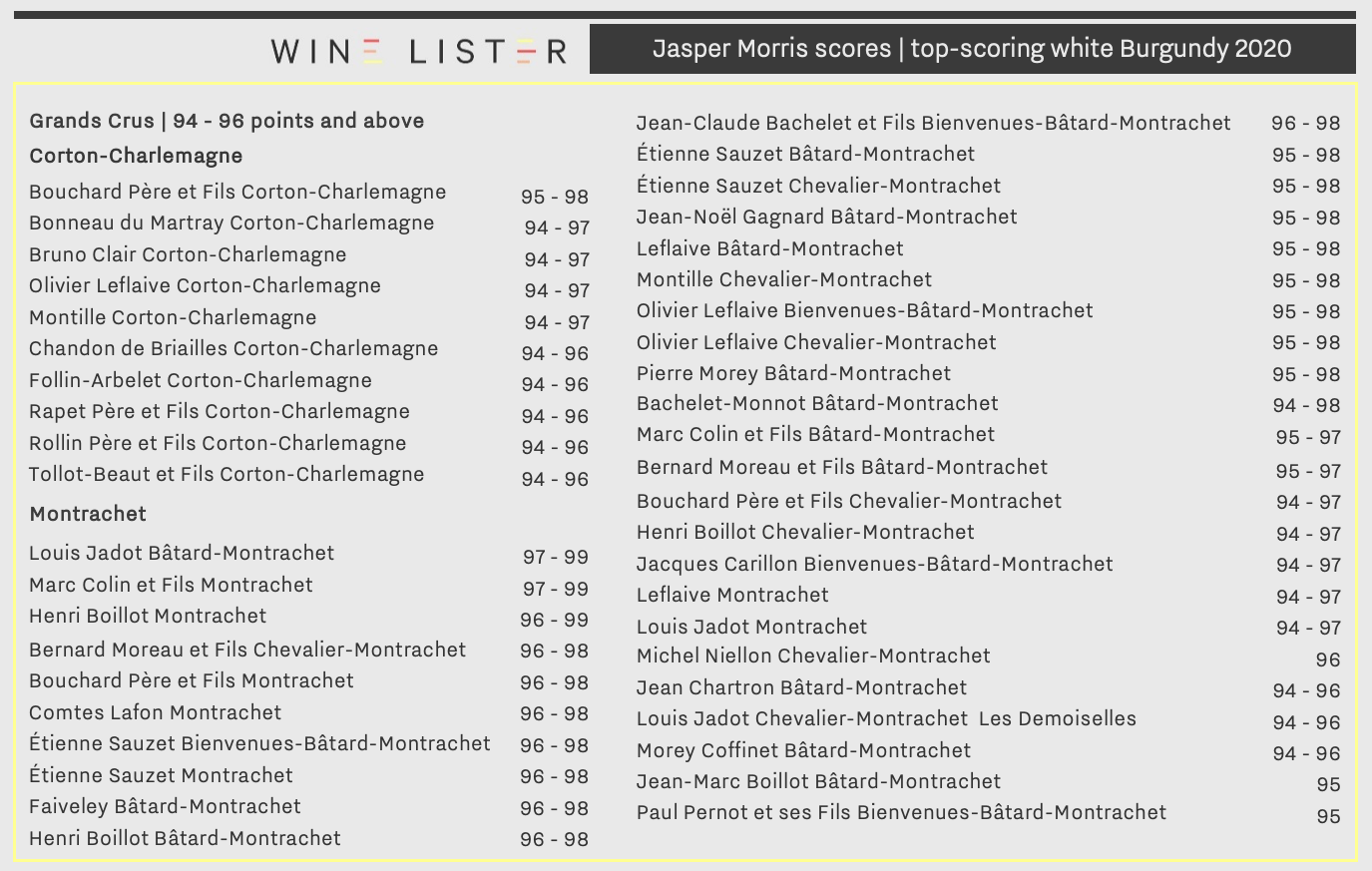
Côte de Beaune – whites
Jasper awards 71 white Burgundy 2020s a score of 94 – 96 and above, compared with last year’s 29 wines scoring 95 and above. He stresses the success of the 2020 vintage across the whites, with Chardonnay grapes retaining more juice than Pinot Noir, and benefitting from a longer ripening time. Montrachet and associated white Grands Crus saw two wines with a potential 99 points – Marc Colin’s Montrachet and Louis Jadot’s Bâtard-Montrachet.
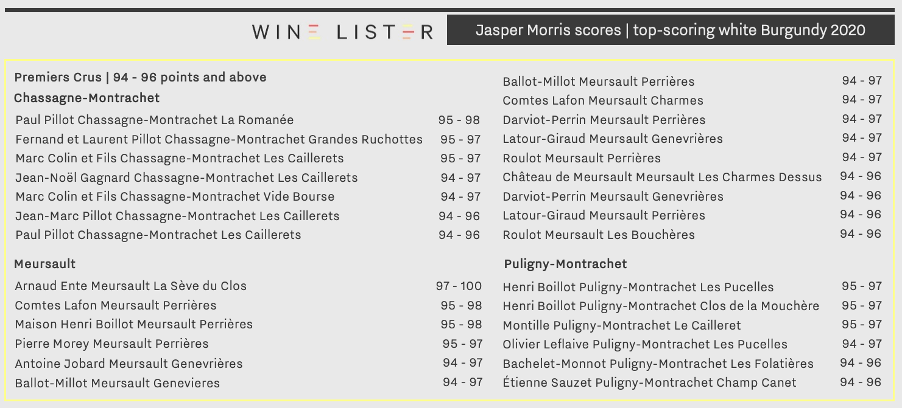
Bouchard Père et Fils’ Corton-Charlemagne achieves a score of 95 – 98, and is praised for expressing “a really impressive wealth of fruit”. Earning the only potential 100-point score for whites in 2020, Arnaud Ente’s Meursault La Sève du Clos was particularly memorable, with Jasper affirming that he has “never seen this consistently great wine as expressive before”.
Explore Jasper Morris’ full Burgundy 2020 report here. For more Burgundy 2020 commentary from our partner critics, recap Neal Martin’s ratings here, and stay tuned for the last lot of scores from Jancis Robinson.com.
The first of Wine Lister’s partner critics to release scores for the latest Burgundy vintage, Neal Martin’s assessment (for Vinous) provides initial insight into some of the top en primeur picks in 2020.
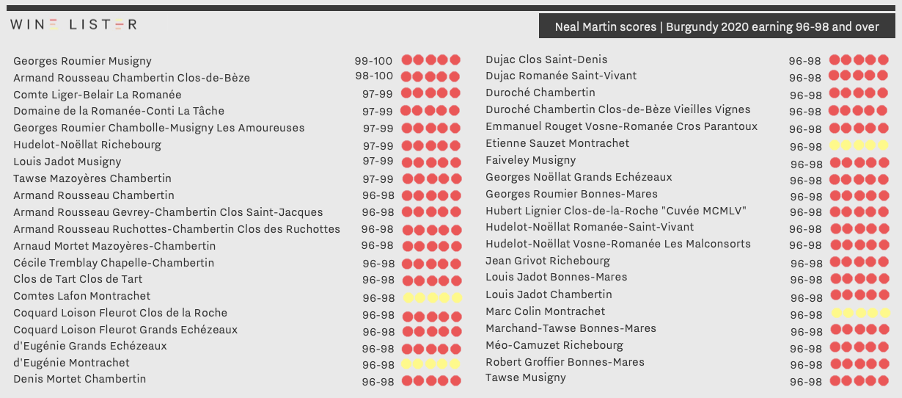
What do we know about Burgundy’s 2020 vintage so far?
2020 will be remembered as a year that saw some of the earliest harvest dates ever recorded in Burgundy, with several of the region’s producers picking as early as 12th August. Though following the pattern of recent vintages marked by warm and dry growing seasons, the threat of drought was partly alleviated by significant rainfall during the winter months through to spring, which ensured water reserves were replenished ahead of the heat. Some Pinot Noir producers nonetheless saw a drop in yields, particularly on sites with poorer soils, and thus restricted water retention ability.
Dry conditions during ripening minimised the threat of disease and mildew, which was valuable for the healthy growth of red and white grapes. Despite the earlier harvest, the grapes saw excellent ripening and phenolic development, while high levels of evaporation concentrated sugars, flavours, and acidity.
The top-scorers
Compared to the 19 wines that Neal Martin awarded 96-98 and above last year, there are an impressive 40 wines within the same parameter for the 2020 vintage. While there were no wines that earned a potential perfect score in 2019, Georges Roumier’s Musigny and Armand Rousseau’s Chambertin Clos-de-Bèze receive 99-100 and 98-100 points respectively in 2020. Neal Martin notes that the top-scoring reds of the vintage all share an excellent acidity, which “lends the 2020s a sense of brightness”.
Also faring notably well, Comte Liger-Belair’s La Romanée, Domaine de la Romanée-Conti’s La Tâche, Georges Roumier’s Chambolle-Musigny Les Amoureuses, Hudelot-Noëllat’s Richebourg, Louis Jadot’s Musigny, and Tawse’s Mazoyères Chambertin earn scores of 97-99.
Whites worth trying
Four whites hailing from Montrachet appear on the list, with offerings from Comtes Lafon, Domaine d’Eugénie, Etienne Sauzet, and Marc Colin each earning a score of 96-98. Neal Martin describes mineral notes across each, having written that this was one of the great attributes of the top whites in the vintage – especially across those grown on more “calcareous soils” akin to that which Montrachet boasts. Following the trend of white burgundy producers using less new oak, Marc Colin uses only old oak barrels for the first time in this vintage, while Comtes Lafon matured Montrachet in one-third new oak instead of 100%.
Discover Neal Martin’s full list of Burgundy 2020 scores here. Watch this space for further Burgundy 2020 score updates from Wine Lister’s partner critics, JancisRobinson.com, and specialist Burgundy critic, Jasper Morris MW.
The insider’s guide to fine wine trends, and the most compelling wines to watch
Wine Lister has released its second annual Wine Leagues, celebrating some of the top-performing wines and producers in today’s new and much-diversified fine wine era. Informed by an in-depth trade survey with leading industry figures, the report provides a 360° view of those regions, producers, and wines that have seen strides in quality, popularity, economic promise, and more in 2021.
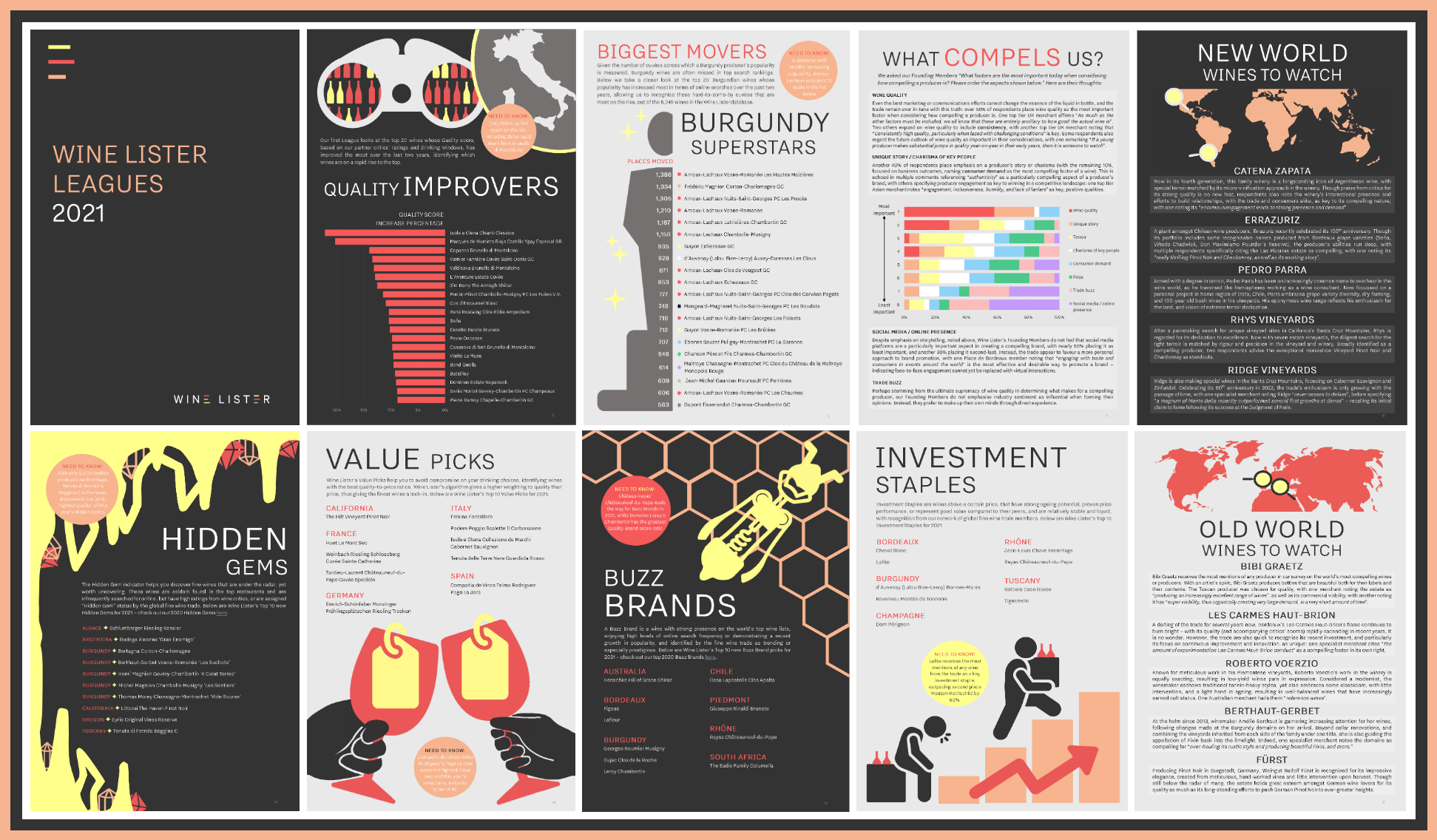
Wine Lister’s annual in-depth survey sees our expert panel of 47 CEOs, MDs, and wine department heads share their insight on some of the fine wines to have on your radar, as we ask them:
“What are the most compelling wines and producers in the market today?”
Respondents singled out 188 wines and producers collectively, that span no less than 20 major regions. Within the list, our team identifies Bibi Graetz, Les Carmes Haut-Brion, Roberto Voerzio, Berthaut-Gerbet, and Fürst as wines to watch in the Old World, whilst calling out the New World wonders of Catena Zapata, Errazuriz, Pedro Parra, Rhys Vineyards, and Ridge Vineyards.
The report also includes rankings across:
- Biggest quality improvers, which show impressive movement from Italy (occupying five places in the list of the top 20 by Quality score progression), with Isole e Olena Chianti Classico leading the pack
- Best search rank movers, wherein Bordeaux represents eight of the top 20 wines whose popularity has increased most in terms of online searches (including Smith Haut Lafitte, Domaine de Chevalier, Figeac, and Léoville Poyferré)
- Burgundy superstars, focusing on popularity movements from the trade’s darling region – Arnoux-Lachaux features 10 times in the list of top 20 Burgundian wines whose online searches have increased the most over the last two years
- Wine Lister’s top-10 recommendations per Wine Lister Indicator; Hidden Gems, Value Picks, Buzz Brands, and Investment Staples in 2021
For the full analysis, download your free copy of Wine Lister’s 2021 Leagues here.
Tales of the 2016 told by Castiglion del Bosco
One of the highest-scoring vintages in recent decades, 2016 has been described as a milestone for Montalcino and its flagship wine, Brunello. Providing the first taste of 2016 Riserva in the UK, WLPR was honoured to accompany Castiglion del Bosco through an early preview of its monumental Riserva Millecento 2016 release (set for January 2022) at London’s Enoteca Turi, joined by a handful of the city’s leading trade figures and fine wine collectors.
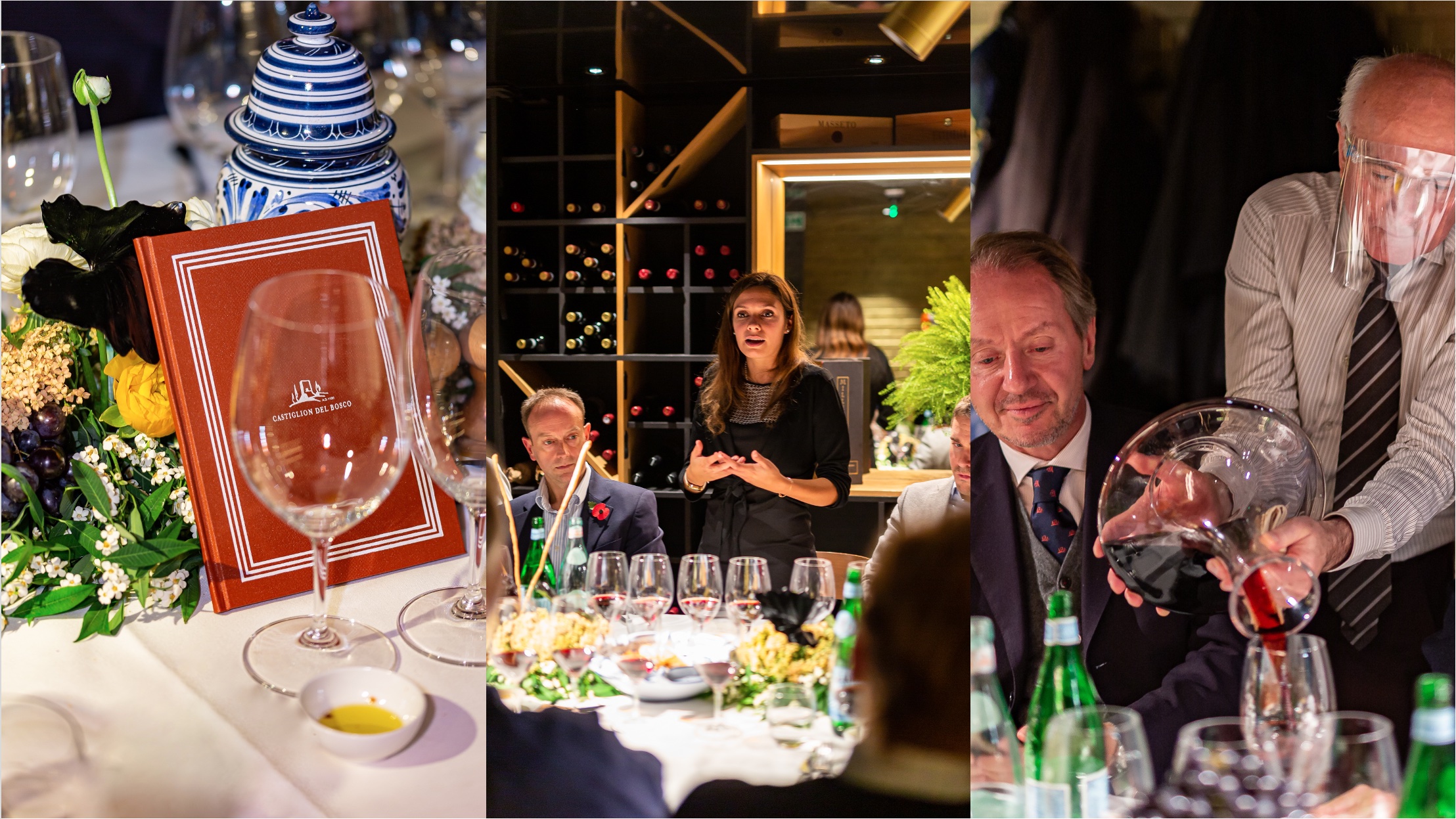 Bespoke menu (left), Castiglion del Bosco’s Marketing Manager, Gemma Grieco talking guests through the line-up (middle), Enoteca Turi owner, Giovanni Turi pouring the wines (right)
Bespoke menu (left), Castiglion del Bosco’s Marketing Manager, Gemma Grieco talking guests through the line-up (middle), Enoteca Turi owner, Giovanni Turi pouring the wines (right)
The 2016 Riserva – some of the best from Brunello?
With big shoes to fill following the release of the highly-praised 2015, the 2016 marks the second great year in a row for Brunello di Montalcino, though very different from its predecessor. Whilst the 2015 growing season was hot and dry, 2016 was slightly cooler, with greater diurnal range during the ripening season. These climatic differences result in the 2015s being more generous in both texture and body, while the successive vintage is pure and elegant, with significant ageing potential.
Having been at the property since its acquisition by Massimo Ferragamo in 2004, Castiglion del Bosco’s winemaker Cecilia Leoneschi describes the 2016 as the estate’s “best ever” Brunello. The mild summer encouraged a long, slow ripening, while good conditions at harvest allowed the estate to “harvest each vineyard at the perfect moment” – resulting in “rich wines with outstanding elegance”.
Cecilia hails the 2016 vintage of Castiglion del Bosco’s Riserva Millecento (so-named due to the property’s original construction in 1100) as having “arrived at our intention”. She refers to creating a wine that reflects the magnificence of the estate’s past, while “representing what we want our future to be”. Finally, she adds that the 2016 relays the estate’s key message with absolute purity, as the growing season allowed her to finetune her senses, and “listen to the land” completely.
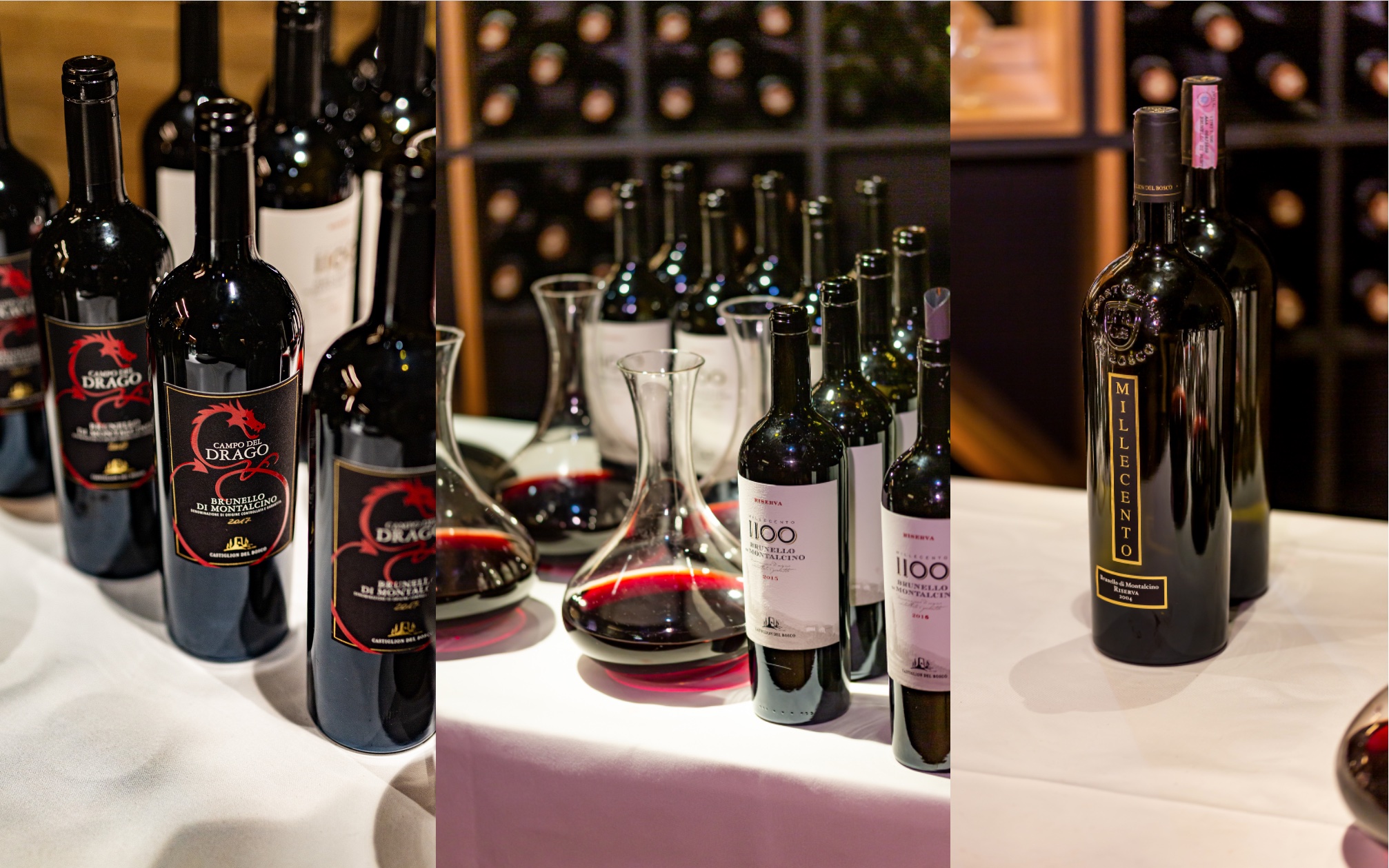 Campo del Drago 2017 (left), Riserva Millecento 2015 and 2016 (middle), and Riserva Millecento 2004 (right)
Campo del Drago 2017 (left), Riserva Millecento 2015 and 2016 (middle), and Riserva Millecento 2004 (right)
Bringing to life the best of Brunello
The Castiglion del Bosco team came to London on Thursday 14th November to tell the tales of the Riserva Millecento 2016 to an audience of 25 industry members and fine wine collectors. Bringing Tuscany to Chelsea, and the estate’s historic past to the present, all guests left with a short storybook, detailing key moments at Castiglion del Bosco that shape the estate’s future, and of course, its wines.
The chosen pouring order of wines, paired with a traditional Tuscan fare from Enoteca Turi’s Head Chef, Massimo Tagliaferri was also symbolic of the changing hands of time, and those traditions maintained – vintages 2004, 2010, 2015, and 2016 we served side-by-side, and tasters were invited to try from 2004 upwards, and back down again.
2004 was the first Riserva made under the current team, while the 2010 was the first to be released under the “Millecento” name. A direct comparison of the 2015 and 2016 – the latest Riserva released, and that which is yet to come – illustrates what Cecilia describes as “two different approaches to quality” in consecutive years.
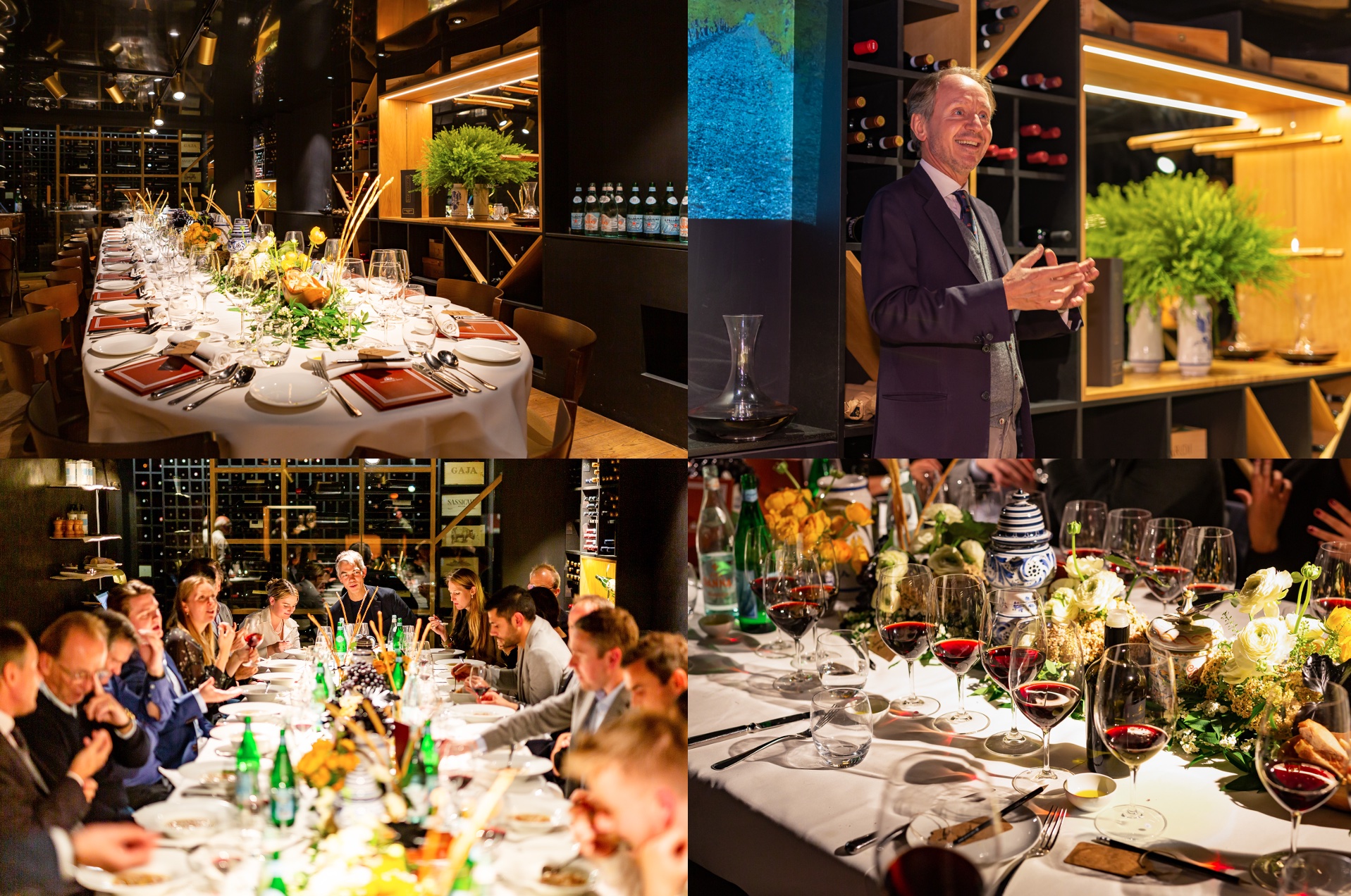 Table designed by Isabelle Buckland (top left), Castiglion del Bosco’s CEO, Simone Pallesi greeting the guests (top right), guests enjoying their aperitivo, Zuppa di Cipolle (bottom left), and the complete Riserva line-up (bottom right)
Table designed by Isabelle Buckland (top left), Castiglion del Bosco’s CEO, Simone Pallesi greeting the guests (top right), guests enjoying their aperitivo, Zuppa di Cipolle (bottom left), and the complete Riserva line-up (bottom right)
Wines tasted: Brunello 2017, Campo del Drago Brunello 2017, Riserva Millecento 2016, Riserva Millecento 2015, Riserva Millecento 2010, and Riserva Millecento 2004 (from Massimo Ferragamo’s private cellar), and a Vin Santo 2014 to finish.
For more information on our organisation of tastings and events, please contact the WLPR team here.
The balancing act
Following our recent report on Bordeaux’s 2021 harvest, Wine Lister now turns to Tuscany to find out more about its 2021 vintage so far, with insight from 10 top producers across the region
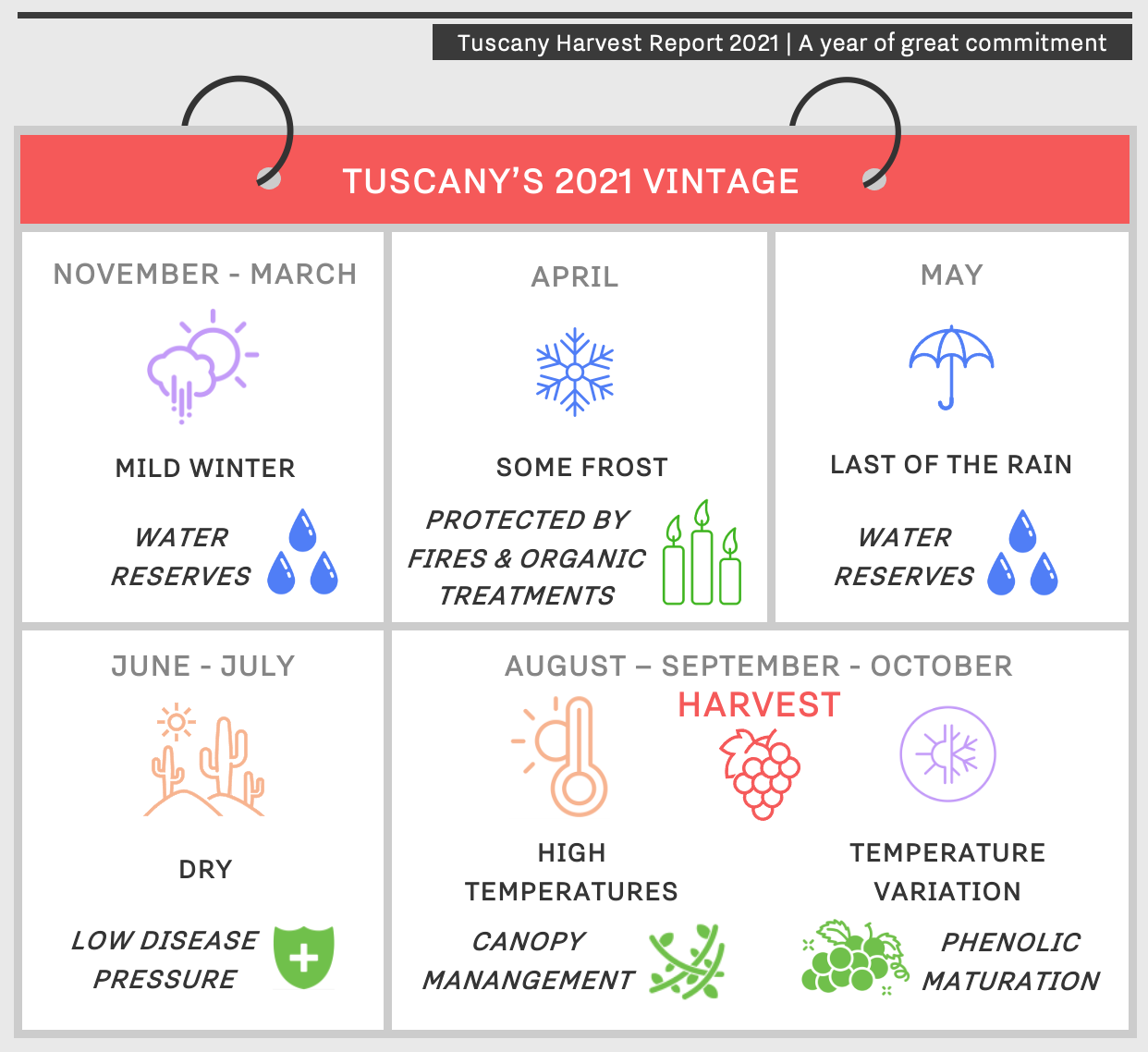
Tuscany’s 2021 growing season has been characterised as a year of climatic extremities, including a mild and rainy winter, the onset of frost in spring, persistent drought in summer, and ending in ideal harvest conditions. In a show of resilience and adaptability, producers were able to reap the benefits of acute weather patterns – with the potential consequences of drought lessened by the groundwater reserves accumulated in winter, and dry conditions reducing disease pressure over the summer.
What can we expect from Tuscany’s 2021 vintage?
Multiple methods to fight frost
- Properties lit fires in the vineyards to circulate warm air and reduce the risk of frost. Owner of IPSUS, Giovanni Mazzei tells us that the technique successfully “increased the temperature up to 2˚C” across the IPSUS vineyards, protecting the vines from damage
- Several producers used organic treatments to improve vine health following the frost, including Argiano, whose Sales Manager, Riccardo Bogi tells us that “brown algae allowed the plants to stabilise and respond as quickly as possible to the loss of sprouts”
- Frost was particularly prevalent in low-lying coastal regions, with Ornellaia’s winemaker, Axel Heinz witnessing “damages limited to a few lower altitude vineyards, without significant impact on production”. Le Macchiole’s Commercial Director, Gianluca Putzolu tells us that the estate also implemented “organic spring fertilization” to combat frost that hit “some, but fortunately very few vineyards”
Water reserves
- Rainfall during winter accumulated important water reserves at both Argiano and Romitorio, encouraging a good state of hydration ahead of the growing season
- Some high-altitude properties also saw snowfall during winter that, when melted, “percolated the soil with water”, according to Romitorio’s owner, Filippo Chia
- Abundant rainfall in May allowed plants to survive the hot summer, with Riccardo confirming that this was “essential” for Argiano’s 2021 vintage, “since after that, there was no rain until the beginning of October”. Similarly, Fèlsina’s owner, Giovanni Poggiali tells us of some “rainy days in June”
Sun and heat exposure
- “The management of the canopy needed to be delicate and precise to avoid sunburns”, explains Avignonesi’s COO and Agronomist, Alessio Gorini, who also explained that the use of high-tech sorting equipment allowed them “to completely remove any berries withered or raisined by the sun”
- Organic treatments were adopted to protect the vines from sun exposure, such as the use of “kaolin” at Tenuta San Guido. General Director, Carlo Paoli explains this to be “a natural substance that we have been using for many years in hot vintages”, which helps to reduce the vines’ susceptibility to scorching
- A broad diurnal range across several high-altitude estates encouraged balance despite the hot summer, with Castiglion del Bosco’s winemaker, Cecilia Leoneschi noting that the difference of more than 10°C between day and night temperatures was a “real blessing”
 Teamwork amongst Tuscan vines: IPSUS (left), Tenuta San Guido (middle), Ornellaia (right)
Teamwork amongst Tuscan vines: IPSUS (left), Tenuta San Guido (middle), Ornellaia (right)
A remarkably healthy vintage
- Lack of rain throughout June and July minimised disease pressure; Filippo confirmed that “from a mould and disease standpoint, it was actually one of the healthiest vintages [Romitorio] has seen”, thanks to the “dry summer”. Giovanni echoes this sentiment for IPSUS, while Gianluca reiterates there were “no particular problems” at Le Macchiole, despite the risk of powdery mildew – a more common problem for the Bolgheri area
Striking when the time was right
- For many estates, harvest timing was essential, with Alessio and the Avignonesi team similarly conscious of “avoiding over-ripening on such concentrated grapes”
- Producers had to be particularly reactive to picking dates, explains Axel – whose 2021 harvest “required great skill” in planning, eventually leading to a “very compact harvest completed in one month, instead of the usual 40 days”. Owner of Tua Rita, Giovanni Frascolla similarly characterised 2021 as a “lightning harvest”
Balanced acidity
- “Powerful dark structure – we normally see this with low acid, but this has high acid” recounts Filippo from Romitorio’s latest tasting of the blend
- First impressions show “bright aromatics and, luckily high acidities to keep everything in balance”, at Ornellaia, with Axel describing a “rich and concentrated” wine, “with soft tannins”
- “Grapes matured in a homogeneous way and with a perfect balance of acidity and PH” explains Carlo at Tenuta San Guido
Working around the clock
Wine Lister catches up with nine top producers from Bordeaux’s Left Bank to find out more about their 2021 harvest, and to hear their early evaluation of the vintage
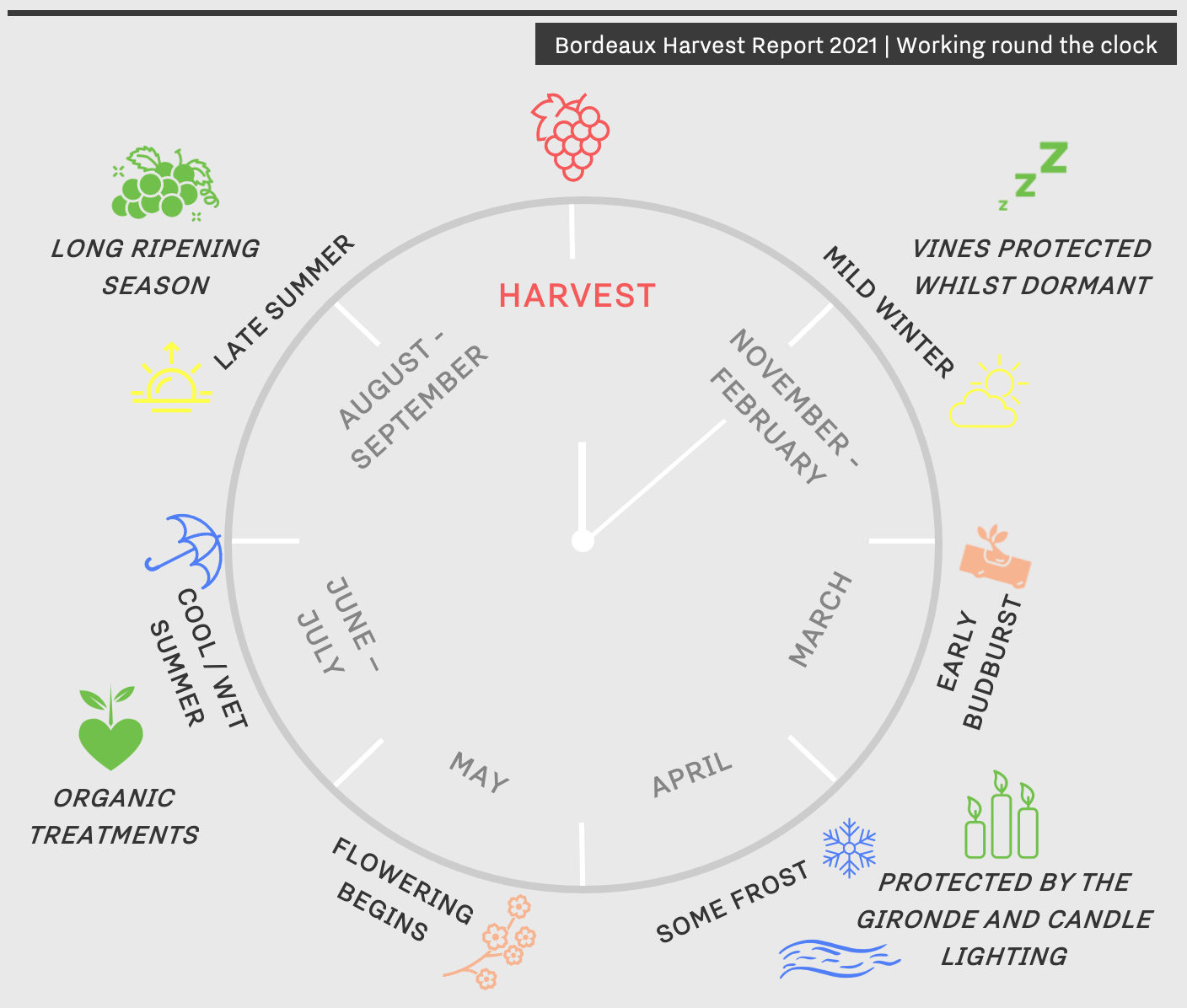
Bordeaux’s 2021 vintage required patience and commitment. Producers worked around the clock to protect their vines – some were threatened by frost, others by disease pressure over the cool and wet summer, but all brought their respective teams together, facing the hand that Mother Nature dealt them with the best experience and techniques the modern wine world has to offer.
What do we know about Bordeaux’s 2021 vintage so far?
Frost protection
- Several producers were protected from the April frost due to their proximity to rivers – just 600m from its banks of the Gironde, d’Issan vineyards escaped damage, according to owner, Emmanuel Cruse. Similarly, Vineyard Manager, Nicolas Dudebout tells us that Malescasse were “naturally shielded” by their privileged positioning near the Garonne
- Other properties were well-equipped to fight the frost proactively, with Smith Haut-Lafitte’s owner Florence Cathiard confirming that a combination of “Valerian decoction (Valeriana officinalis plant root used for its restorative properties), and candles” protected their vines
Organics against disease pressure
- The cool and wet start to summer left some producers vulnerable to disease pressure: Florence told us that Smith Haut-Lafitte reacted to the threat of mildew using “copper mixed with phytotherapy decoctions of horsetail, nettle, wicker, and comfrey”
- “We take the best of both worlds” at Larrivet Haut-Brion, describes Cellar Master, Charlotte Mignon. She explains that the team were “reactive to fighting mildew attacks”, using biocontrol to facilitate the sustainable use of “organic, biodynamic, and conventional solutions [as] necessary”
Late summer ripening
- Late summer sun in August and September created favourable conditions for Merlot, an early-ripening grape variety that is notoriously challenging in hotter temperatures. Cos d’Estournel’s Technical Director, Dominique Arangoïts, found their Merlot to be “remarkably enticing, fruity, and rich with a very noble expression”
- Slower ripening of Cabernet Sauvignon grapes encouraged good phenological maturity: During his last harvest at Lafon-Rochet, Basile Tesseron tells us that, following early pre-harvest berry tastings, the grapes fortunately progressed beautifully in the last few weeks, eventually becoming “more expressive, and well-balanced”
- After a trio of warmer vintages, Charlotte notes that the Cabernets at Larrivet Haut-Brion achieved “perfect ripeness”, thanks to a longer growing season, and sunshine in late-August right up until harvest in October, which gave grapes with “a very good state of health”
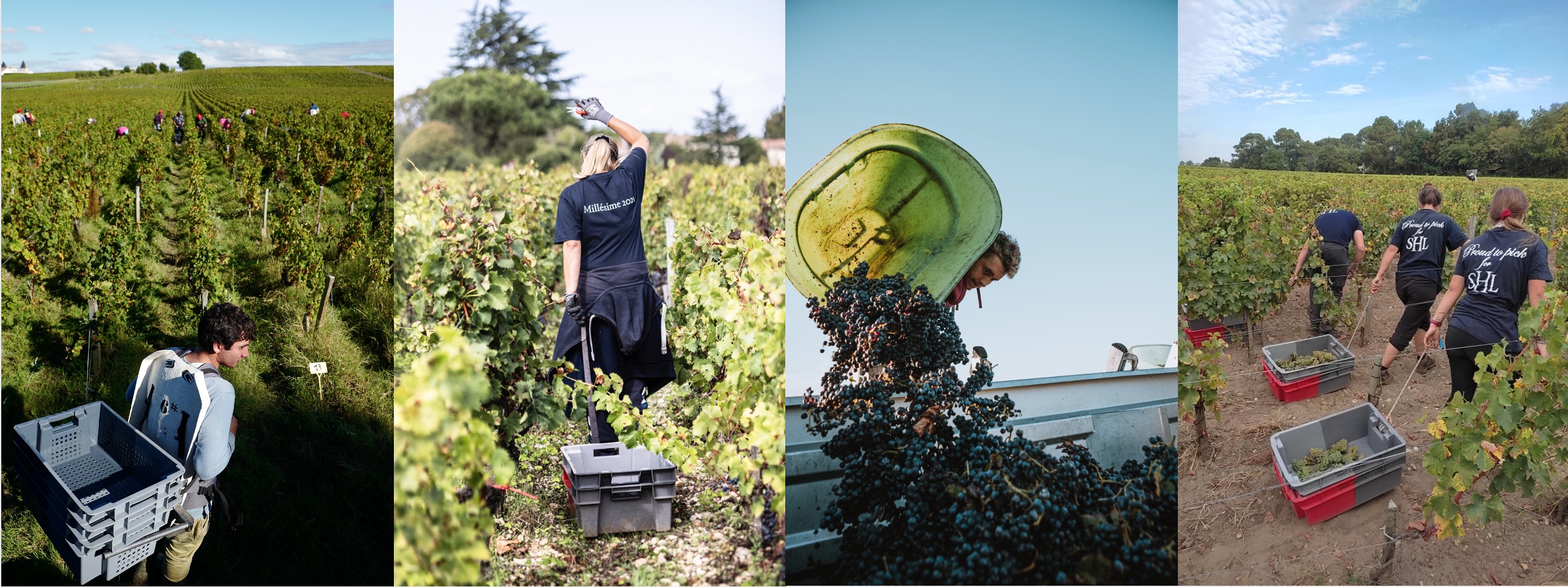 A snapshot of this year’s harvest: Lafon-Rochet (far left), Palmer (middle left), d’Issan (middle right), and Smith Haut-Lafitte (far right)
A snapshot of this year’s harvest: Lafon-Rochet (far left), Palmer (middle left), d’Issan (middle right), and Smith Haut-Lafitte (far right)
Lower alcohol content
- “Low levels of sugar have resulted in a lower alcohol content” in Cos d’Estournel’s Cabernet Sauvignon this year, with Dominique identifying “a magnificent intensity and freshness” and the characteristics of “the most elegant, sophisticated wines”
- “This harvest will be marked by an alcohol-acidity balance, completely different from previous years”, observes Haut-Brion’s Technical Director, Jean-Philippe Masclef. Their Cellar Master, Florence Forgas associates “moderate alcoholic degrees” as being “closer to much older vintages”
- A cooler vintage compared to the previous three resulted in “pure fruit, and a very interesting density” in Palmer’s 2021 grapes, according to Thomas Duroux
Good things to come
- “Merlots are softer than usual and the Cabernets more compact” according to Cantenac Brown’s winemaker José Sanfins, who hopes for an overall blend that is “dense and complete, with fine and elegant tannins”
- Favourable weather during harvest, including “morning temperatures of around 4˚C, preserving freshness across all grape varieties” at d’Issan
- Bordeaux’s whites also boast vibrancy in 2021, with Charlotte noting “freshness and tension” with “aromatic clarity” from Larrivet Haut-Brion’s Sauvignon Blanc and Sémillon grapes
 Bordeaux study (p.10): Founding members survey – 2021 release price expectations
Bordeaux study (p.10): Founding members survey – 2021 release price expectations










 Bespoke menu (left), Castiglion del Bosco’s Marketing Manager, Gemma Grieco talking guests through the line-up (middle), Enoteca Turi owner, Giovanni Turi pouring the wines (right)
Bespoke menu (left), Castiglion del Bosco’s Marketing Manager, Gemma Grieco talking guests through the line-up (middle), Enoteca Turi owner, Giovanni Turi pouring the wines (right) Campo del Drago 2017 (left), Riserva Millecento 2015 and 2016 (middle), and Riserva Millecento 2004 (right)
Campo del Drago 2017 (left), Riserva Millecento 2015 and 2016 (middle), and Riserva Millecento 2004 (right) Table designed by Isabelle Buckland (top left), Castiglion del Bosco’s CEO, Simone Pallesi greeting the guests (top right), guests enjoying their aperitivo, Zuppa di Cipolle (bottom left), and the complete Riserva line-up (bottom right)
Table designed by Isabelle Buckland (top left), Castiglion del Bosco’s CEO, Simone Pallesi greeting the guests (top right), guests enjoying their aperitivo, Zuppa di Cipolle (bottom left), and the complete Riserva line-up (bottom right)
 Teamwork amongst Tuscan vines: IPSUS (left), Tenuta San Guido (middle), Ornellaia (right)
Teamwork amongst Tuscan vines: IPSUS (left), Tenuta San Guido (middle), Ornellaia (right)
 A snapshot of this year’s harvest: Lafon-Rochet (far left), Palmer (middle left), d’Issan (middle right), and Smith Haut-Lafitte (far right)
A snapshot of this year’s harvest: Lafon-Rochet (far left), Palmer (middle left), d’Issan (middle right), and Smith Haut-Lafitte (far right)